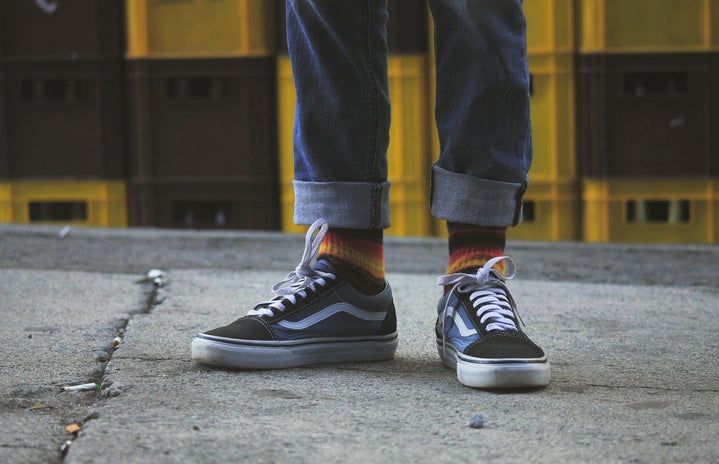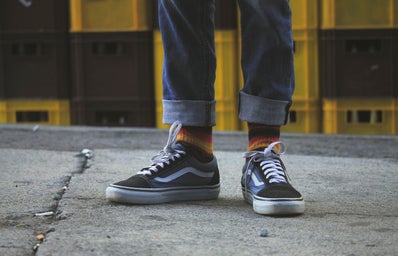Kelsey Kasom has taken full advantage of everything Columbia has to offer. Coming from Richmond, a small town in Michigan, she has brought her unique outlook on life and put it into art. Kelsey is a senior this year working on her thesis and many students and teachers are excited to see what she comes up with! On a full scholarship and with many honors and awards, Kelsey is definitley the girl to watch in the fashion department.
HC: What made you choose fashion design?KK: “When I was little, my pap asked me what I wanted to be when I grew up. I told him I was going to be a fashion designer and go to school in Chicago. I was about 7 and I remember him laughing at me. He pointed out my Levis covered in grass stains and my favorite Joe Boxer tank top I got from K-mart, that was also covered in mud and holes, but I didn’t care. It never fazed me that I didn’t have very many clothes growing up other then than hand-me-downs and things from our local store. I don’t think I had ever been to a mall until I was much older. When I got a little older I asked for a mannequin for my birthday. My mom and aunt surprised me with one from a garage sale. Every Sunday my mom would take me to the flee market and I would unload all the change I had on all the scarfs I could find there. My parents left me home alone a lot growing up; my dad was always working and my mom was always outside or with my older sister. So in my down time, I would close the door to my room and make things I imagined in my head with the scarfs on this mannequin. I would do this for hours; tying things together, trying to make clothes, imagining that every scarf was the same pattern and color. Imagining myself in them and dreaming while awake. I asked my mom for some pins one day and I started pleating with them. I didn’t know what I was doing or that there were words for my actions. I didn’t know that dresses existed like this in real life, I was just playing. I used to run and tell my mom to come look and beg people to see what I did, but I grew impatient and would take it apart and make something new. No one really ever knew what I was doing until I started leaving things on the mannequin over night. My mom let me photograph the things I was making- they are on my Photobucket account from when I was in 3rdgrade.I remember my mom saying, “How do you expect to do anything with this if you can’t sew?”. I always wanted an American Girl Doll, so I cut up my clothes, cut patterns into them, cut my pillow open, took the stuffing out of it, and hand sewed my doll together. I drew a face on her and tried to make her my look a-like, or at least what I thought I looked like, and I still have her today. I started making things out of my dads old work shirts. I took the sleeves and made myself shorts, and then wove ribbon through the waist to make them draw string. I made purses out of my beat up jeans and tried to sell them at school in 4th grade. I used gloves as pockets, a shirt tie as a shoulder strap, and a belt to close the purse. I was embroidering and didn’t even know it for the longest time. I never had a circle thing, I just free-handed and drew images in my old clothes. When I got to high school, I was strictly fine art. I created everything. I knew it would be hard to make a living from this and I realized I wanted to make art that people could wear. So I decided to wing it and go to school for fashion design and pursue those early childhood goals of mine. It was a risk because I had never actually sewn anything before on a machine going into my first year at Columbia but I learned how to fast.”
HC: What inspires you?KK: “Feeling, intuition, memory, and emotion. Music puts me in flow with my thoughts and I run with those. If I can control my thoughts going into “playtime” then I can usually create something I am feeling through the music I listen to. It’s hard because I am not even sure how I do a lot of the things I do because I am in such a deep state of flow, which is common with most artists. I find myself using shape a lot and experimenting with things that don’t contrast and making a connection through their differences so they complement each other. I like the challenge in that. Problem solving also inspires me, I make the best mistake sometimes. I love words, quotes, or sayings; I can make things with that thought and feeling in mind. I go with what feels right and natural. When being innovative in “challenges” or projects, I try to resort to what I know best. If I have a single idea, I can run with that. Growing up with very little, I learned to make things become other things, like clothes pins are also building blocks that I would stack like Legos. I once made a garment inspired by this memory as a child to create something like a staircase. This seemed very natural to me. Sometimes I dream what my projects should be and I write the thought down. It’s is something that use to happen a lot when I first came to Columbia. I find inspiration in the little things that people tend to over look or not acknowledge for what it could be.”
HC: How was your transition from a small town to a big city?KK: “It was very hard. I had never been to Chicago and I didn’t have much support in my pursuits coming here. I was my number one fan and also my one supporter for a very long time. But I was very open-minded and optimistic. I quickly learned the appreciation I had for the smaller things in life, where they are in our surroundings daily and how they are so commonly overlooked. I don’t take anything for granted. Also, I am very humble about where I came from and also where I am currently. I wasn’t afraid, but more curious. I had a job to do here, a goal, and I plan to fulfill that this year. My contract is almost expired here in the concrete jungle, as I like to say. After a while I grew very depressed with living here. It is very grey compared to what I used to see. I guess I kind of just accepted I had something I needed to accomplish and I was going to do it regardless of where I was, which I am still working on! My work kind of reflects how I feel here; trapped and suffocated, sacrificing for passion of innovation and creation. However, I have learned a lot and grown so much as a person from this environmental shock I put myself through yearly. I just try never to loose those roots and conform into someone other then who I am.”
HC:Where do you hope to be after graduation?KK: “I don’t see myself having the time I would need to apply for the internships while creating thesis, in which would best fit my esthetic. But it’s also to soon for me to tell. If time does fall short, I intend to volunteer my time through AmeriCorps and help rebuild the lives and environments of those suffering from poverty or natural disaster. During this time, I will be applying for internships. I see myself more toward the avant-garde construction processes than I do ready-to-wear. I have always had the hands of a fine artist and I think it would be a struggle for me to settle by pursuing something outside of where my heart is. I feel my best bet is to take my capabilities outside the U.S. Unfortunately, I would be leaving the nest further than I hoped. But I would have intentions of one day returning and being successful enough to be a designer in the States and contributing to the avant-garde competitiveness outside the U.S. Also, grad school is something I have been pondering over. I may consider going to grad school abraod to further myself, and also more forcefully put myself in that element, in hopes of being more recognized and taken seriously competing with people out there.”
HC: What accomplishment are you most proud of?KK: “Zero Waste Sari Competition winner- Spring 2015.”

